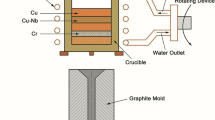Abstract
Quenched and slowly cooled (annealed) Cu–0.7 %Cr, Cu–0.9 %Hf, and Cu–0.7 %Cr–0.9 %Hf alloys were processed by high pressure torsion (HPT). The microstructures of the alloys were studied immediately after HPT and subsequent annealing. It has been shown that the microhardness and the thermal stability of the severely deformed microstructure increase, while the average grain size decreases in the order of Cu–0.7 %Cr, Cu–0.9 %Hf, and Cu–0.7 %Cr–0.9 %Hf alloys. The microhardness in all alloys is higher after quenching and HPT, than after annealing and HPT. The largest dislocation density is achieved by quenching and HPT in Hf-containing samples. Cu5Hf phase precipitations in Hf-containing alloys are more effective in retarding grain growth in comparison with Cr particles and lead to additional hardening during aging. It has been demonstrated that HPT-processing with subsequent heat-treatment might yield the combination of large hardness and high electrical conductivity in Cu alloys.






Similar content being viewed by others
References
Lowe TC, Valiev RZ (2000) Investigations and applications of severe plastic deformation. Kluwer Academic Publishing, Dordrecht
Zehetbauer MJ, Zhu YT (eds) (2009) Bulk nanostructured materials. Wiley, Weinheim
Valiev RZ, Zhilyaev AP, Langdon TG (2014) Bulk nanostructured materials: fundamentals and applications. Wiley, Hoboken, New Jersey
Sitarama Raju K, Subramanya Sarma V, Kauffmann A, Hegedus Z, Gubicza J, Peterlechner M, Freudenberger J, Wilde G (2013) High strength and ductile ultrafine-grained Cu–Ag alloy through bimodal grain size, dislocation density and solute distribution. Acta Mater. 61:228–238
Vinogradov A, Patlan V, Suzuki Y, Kitagawa K, Kopylov VI (2002) Structure and properties of ultra-fine grain Cu–Cr–Zr alloy produced by equal-channel angular pressing. Acta Mater. 50:1639–1651
Vinogradov A, Ishida T, Kitagawa K, Kopylov VI (2005) Effect of strain path on structure and mechanical behavior of ultra-fine grain Cu–Cr alloy produced by equal-channel angular pressing. Acta Mater. 53:2181–2192
Amouyal Y, Divinski SV, Estrin Y, Rabkin E (2007) Short-circuit diffusion in an ultrafine-grained copper–zirconium alloy produced by equal channel angular pressing. Acta Mater. 55:5968–5979
Kužel R, Cherkaska V, Matěj Z, Janeček M, Čížek J, Dopita M, Kristallogr Z (2008) Structural studies of submicrocrystalline copper and copper composites by different methods. Hausz fur Krist Suppl. 27:73–80
Wang QJ, Xu CZ, Zheng MS, Zhu JW, Du ZZ (2008) Fatigue crack initiation life prediction of ultra-fine grain chromium–bronze prepared by equal-channel angular pressing. Mater Sci Eng A. 496:434–438
Dopita M, Janeček M, Rafaja D, Uhlíř J, Matěj Z, Kužel R (2009) EBSD investigation of the grain boundary distributions in ultrarine-grained Cu and Cu-Zr polycrystals prepared by equal-channel angular pressing. Int J Mater Res. 100(6):785–789
Janeček M, Čížek J, Dopita M, Král R, Srba O (2008) Mechanical properties and microstructure development of ultrafine-grained Cu processed by ECAP. Mater Sci. Forum 584–586:440–445
Kužel R, Janeček M, Matěj Z, Čížek J, Dopita M, Srba O (2009) Microstructure of equal-channel angular pressed Cu and Cu-Zr samples studied by different methods. Metall Mater Trans A. 41(5):1174–1190
Valdes Leyn K, Munoz-Morris MA, Morris DG (2012) Optimisation of strength and ductility of Cu–Cr–Zr by combining severe plastic deformation and precipitation. Mater Sci Eng A. 536:181–189
Wongsa-Ngam J, Kawasaki M, Langdon TG (2012) The development of hardness homogeneity in a Cu–Zr alloy processed by equal-channel angular pressing. Mater Sci Eng A. 556:526–532
Jayakumara PK, Balasubramaniana K, Rabindranath Tagoreb G (2012) Recrystallisation and bonding behaviour of ultra fine grained copper and Cu–Cr–Zr alloy using ECAP. Mater Sci Eng A. 538:7–13
Dopita M, Janeček M, Kužel R, Seifert HJ, Dobatkin S (2010) Microstructure evolution of CuZr polycrystals processed by high-pressure torsion. J Mater Sci. 45:4631–4644. doi:10.1007/s10853-010-4643-9
Wongsa-Ngam J, Kawasaki M, Zhao Y, Langdon TG (2011) Microstructural evolution and mechanical properties of a Cu–Zr alloy processed by high-pressure torsion. Mater Sci Eng A. 528(25–26):7715–7722
Shangina DV, Bochvar NR, Dobatkin SV (2011) Structure and properties of ultrafine-grained Cu–Cr alloys after high pressure torsion. Mater Sci Forum. 667–669:301–306
Wongsa-Ngam J, Kawasaki M, Langdon TG (2012) Achieving homogeneity in a Cu–Zr alloy processed by high-pressure torsion. J Mater Sci. 47(22):7782–7788. doi:10.1007/s10853-012-6587-8
Shangina DV, Bochvar NR, Dobatkin SV (2012) The effect of alloying with hafnium on the thermal stability of chromium bronze after severe plastic deformation. J Mater Sci. 47(22):7764–7769. doi:10.1007/s10853-012-6525-9
Dobatkin SV, Shangina DV, Bochvar NR, Janecek M (2014) Effect of deformation schedules and initial states on structure and properties of Cu-0.18 % Zr alloy after high-pressure torsion and heating. Mater Sci Eng A. 598:288–292
Ribárik G, Gubicza J, Ungár T (2004) Correlation between strength and microstructure of ball-milled Al–Mg alloys determined by X-ray diffraction. Mater Sci Eng A. 387–389:343–347
Balogh L, Ribárik G, Ungár T (2006) Stacking faults and twin boundaries in fcc crystals determined by X-ray diffraction profile analysis. J Appl Phys. 100:023512
Gubicza J, Dobatkin SV, Khosravi E, Kuznetsov AA, Lábár JL (2011) Microstructural stability of Cu processed by different routes of severe plastic deformation. Mater Sci Eng A. 528:1828–1832
Acknowledgements
The work was supported by the Russian Foundation for Basic Research (Project13-08-00102), ERA.NetRUS (ProjectSTP-219), the Ministry of Education and Science of the Russian Federation (Project No.14.A12.31.0001) and the Hungarian Scientific Research Fund, OTKA, Grant No. K-109021.
Author information
Authors and Affiliations
Corresponding author
Rights and permissions
About this article
Cite this article
Shangina, D.V., Gubicza, J., Dodony, E. et al. Improvement of strength and conductivity in Cu-alloys with the application of high pressure torsion and subsequent heat-treatments. J Mater Sci 49, 6674–6681 (2014). https://doi.org/10.1007/s10853-014-8339-4
Received:
Accepted:
Published:
Issue Date:
DOI: https://doi.org/10.1007/s10853-014-8339-4




